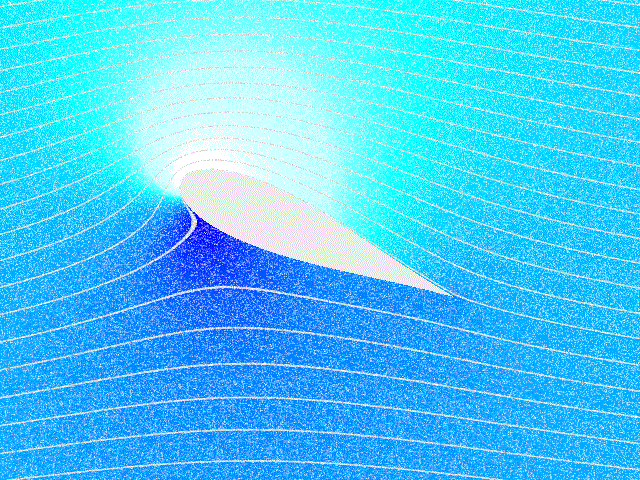|
Landau–Levich Problem
In fluid dynamics, Landau–Levich flow or the Landau–Levich problem describes the flow created by a moving plate which is pulled out of a liquid surface. Landau–Levich flow finds many applications in thin film coating. The solution to the problem was described by Lev Landau and Veniamin Levich in 1942.Ter Haar, D. (Ed.). (2013). Collected papers of LD Landau. Elsevier. The problem assumes that the plate is dragged out of the liquid slowly, so that the three major forces which are in balance are viscous force, the force due to gravity, and the force due to surface tension. Problem Landau and Levich split the entire flow regime into two regimes, a lower regime and an upper regime. In the lower regime closer to the liquid surface, the flow is assumed to be static, leading to the problem of the Young–Laplace equation In physics, the Young–Laplace equation () is an algebraic equation that describes the capillary pressure difference sustained across the interface between tw ... [...More Info...] [...Related Items...] OR: [Wikipedia] [Google] [Baidu] |
Fluid Dynamics
In physics and engineering, fluid dynamics is a subdiscipline of fluid mechanics that describes the flow of fluids— liquids and gases. It has several subdisciplines, including ''aerodynamics'' (the study of air and other gases in motion) and hydrodynamics (the study of liquids in motion). Fluid dynamics has a wide range of applications, including calculating forces and moments on aircraft, determining the mass flow rate of petroleum through pipelines, predicting weather patterns, understanding nebulae in interstellar space and modelling fission weapon detonation. Fluid dynamics offers a systematic structure—which underlies these practical disciplines—that embraces empirical and semi-empirical laws derived from flow measurement and used to solve practical problems. The solution to a fluid dynamics problem typically involves the calculation of various properties of the fluid, such as flow velocity, pressure, density, and temperature, as functions of space and time. ... [...More Info...] [...Related Items...] OR: [Wikipedia] [Google] [Baidu] |
Thin Film
A thin film is a layer of material ranging from fractions of a nanometer (monolayer) to several micrometers in thickness. The controlled synthesis of materials as thin films (a process referred to as deposition) is a fundamental step in many applications. A familiar example is the household mirror, which typically has a thin metal coating on the back of a sheet of glass to form a reflective interface. The process of silvering was once commonly used to produce mirrors, while more recently the metal layer is deposited using techniques such as sputtering. Advances in thin film deposition techniques during the 20th century have enabled a wide range of technological breakthroughs in areas such as magnetic recording media, electronic semiconductor devices, integrated passive devices, LEDs, optical coatings (such as antireflective coatings), hard coatings on cutting tools, and for both energy generation (e.g. thin-film solar cells) and storage ( thin-film batteries). It is also being ... [...More Info...] [...Related Items...] OR: [Wikipedia] [Google] [Baidu] |
Lev Landau
Lev Davidovich Landau (russian: Лев Дави́дович Ланда́у; 22 January 1908 – 1 April 1968) was a Soviet- Azerbaijani physicist of Jewish descent who made fundamental contributions to many areas of theoretical physics. His accomplishments include the independent co-discovery of the density matrix method in quantum mechanics (alongside John von Neumann), the quantum mechanical theory of diamagnetism, the theory of superfluidity, the theory of second-order phase transitions, the Ginzburg–Landau theory of superconductivity, the theory of Fermi liquids, the explanation of Landau damping in plasma physics, the Landau pole in quantum electrodynamics, the two-component theory of neutrinos, and Landau's equations for ''S'' matrix singularities. He received the 1962 Nobel Prize in Physics for his development of a mathematical theory of superfluidity that accounts for the properties of liquid helium II at a temperature below (). Life Early years Landau was born ... [...More Info...] [...Related Items...] OR: [Wikipedia] [Google] [Baidu] |
Veniamin Levich
Veniamin Grigorievich (Benjamin) Levich (russian: Вениами́н Григо́рьевич Ле́вич; 30 March 1917 in Kharkiv, Ukraine – 19 January 1987 in Englewood, New Jersey, United States) was a Soviet dissident, internationally prominent physical chemist, electrochemist and founder of the discipline of physico-chemical hydrodynamics. He was a student of the theoretical physicist, Lev Landau. His landmark textbook titled ''Physicochemical Hydrodynamics'' is widely considered his most important contribution to science. The Levich equation describing a current at a rotating disk electrode is named after him. His research activities also included gas-phase collision reactions, electrochemistry, and the quantum mechanics of electron transfer. Levich received many honors during his life, including the Olin Palladium Award of The Electrochemical Society in 1973. He was elected a foreign member of the Norwegian Academy of Sciences in 1977 and a foreign associate of the U. ... [...More Info...] [...Related Items...] OR: [Wikipedia] [Google] [Baidu] |
Young–Laplace Equation
In physics, the Young–Laplace equation () is an algebraic equation that describes the capillary pressure difference sustained across the interface between two static fluids, such as water and air, due to the phenomenon of surface tension or wall tension, although use of the latter is only applicable if assuming that the wall is very thin. The Young–Laplace equation relates the pressure difference to the shape of the surface or wall and it is fundamentally important in the study of static capillary surfaces. It's a statement of normal stress balance for static fluids meeting at an interface, where the interface is treated as a surface (zero thickness): \begin \Delta p &= -\gamma \nabla \cdot \hat n \\ &= -2\gamma H_f \\ &= -\gamma \left(\frac + \frac\right) \end where \Delta p is the Laplace pressure, the pressure difference across the fluid interface (the exterior pressure minus the interior pressure), \gamma is the surface tension (or wall tension), \hat n is the unit norm ... [...More Info...] [...Related Items...] OR: [Wikipedia] [Google] [Baidu] |
Lubrication Theory
In fluid dynamics, lubrication theory describes the flow of fluids (liquids or gases) in a geometry in which one dimension is significantly smaller than the others. An example is the flow above air hockey tables, where the thickness of the air layer beneath the puck is much smaller than the dimensions of the puck itself. Internal flows are those where the fluid is fully bounded. Internal flow lubrication theory has many industrial applications because of its role in the design of fluid bearings. Here a key goal of lubrication theory is to determine the pressure distribution in the fluid volume, and hence the forces on the bearing components. The working fluid in this case is often termed a lubricant. Free film lubrication theory is concerned with the case in which one of the surfaces containing the fluid is a free surface. In that case the position of the free surface is itself unknown, and one goal of lubrication theory is then to determine this. Examples include the flow o ... [...More Info...] [...Related Items...] OR: [Wikipedia] [Google] [Baidu] |
Method Of Matched Asymptotic Expansions
In mathematics, the method of matched asymptotic expansions is a common approach to finding an accurate approximation to the solution to an equation, or system of equations. It is particularly used when solving singularly perturbed differential equations. It involves finding several different approximate solutions, each of which is valid (i.e. accurate) for part of the range of the independent variable, and then combining these different solutions together to give a single approximate solution that is valid for the whole range of values of the independent variable. In the Russian literature, these methods were known under the name of "intermediate asymptotics" and were introduced in the work of Yakov Zeldovich and Grigory Barenblatt. Method overview In a large class of singularly perturbed problems, the domain may be divided into two or more subdomains. In one of these, often the largest, the solution is accurately approximated by an asymptotic series found by treating the problem ... [...More Info...] [...Related Items...] OR: [Wikipedia] [Google] [Baidu] |
Flow Regimes
Flow may refer to: Science and technology * Fluid flow, the motion of a gas or liquid * Flow (geomorphology), a type of mass wasting or slope movement in geomorphology * Flow (mathematics), a group action of the real numbers on a set * Flow (psychology), a mental state of being fully immersed and focused * Flow, a spacecraft of NASA's GRAIL program Computing * Flow network, graph-theoretic version of a mathematical flow * Flow analysis * Calligra Flow, free diagramming software * Dataflow, a broad concept in computer systems with many different meanings * Microsoft Flow (renamed to Power Automate in 2019), a workflow toolkit in Microsoft Dynamics * Neos Flow, a free and open source web application framework written in PHP * webMethods Flow, a graphical programming language * FLOW (programming language), an educational programming language from the 1970s * Flow (web browser), a web browser with a proprietary rendering engine Arts, entertainment and media * ''Flow'' (journal), ... [...More Info...] [...Related Items...] OR: [Wikipedia] [Google] [Baidu] |
Fluid Dynamics
In physics and engineering, fluid dynamics is a subdiscipline of fluid mechanics that describes the flow of fluids— liquids and gases. It has several subdisciplines, including ''aerodynamics'' (the study of air and other gases in motion) and hydrodynamics (the study of liquids in motion). Fluid dynamics has a wide range of applications, including calculating forces and moments on aircraft, determining the mass flow rate of petroleum through pipelines, predicting weather patterns, understanding nebulae in interstellar space and modelling fission weapon detonation. Fluid dynamics offers a systematic structure—which underlies these practical disciplines—that embraces empirical and semi-empirical laws derived from flow measurement and used to solve practical problems. The solution to a fluid dynamics problem typically involves the calculation of various properties of the fluid, such as flow velocity, pressure, density, and temperature, as functions of space and time. ... [...More Info...] [...Related Items...] OR: [Wikipedia] [Google] [Baidu] |
Thin Film Deposition
A thin film is a layer of material ranging from fractions of a nanometer (monolayer) to several micrometers in thickness. The controlled synthesis of materials as thin films (a process referred to as deposition) is a fundamental step in many applications. A familiar example is the household mirror, which typically has a thin metal coating on the back of a sheet of glass to form a reflective interface. The process of silvering was once commonly used to produce mirrors, while more recently the metal layer is deposited using techniques such as sputtering. Advances in thin film deposition techniques during the 20th century have enabled a wide range of technological breakthroughs in areas such as magnetic recording media, electronic semiconductor devices, integrated passive devices, LEDs, optical coatings (such as antireflective coatings), hard coatings on cutting tools, and for both energy generation (e.g. thin-film solar cells) and storage ( thin-film batteries). It is also being ... [...More Info...] [...Related Items...] OR: [Wikipedia] [Google] [Baidu] |
_250_nm_by_250_nm_image_of_one-atom-thick_silver_islands_grown_on_palladium_(111)_surface.png)


